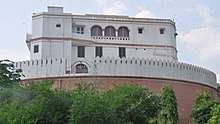Kuchesar Fort
Kuchesar (कुचेसर) Fort, also known as Mud Fort Kuchesar, (or solely the Mud Fort) is located in Kuchesar, Uttar Pradesh, India, approximately 84.3 kilometres east of Delhi. The fort was built in 1734 by the rulers of Kuchesar as an opium trading depot. Several royal heirs inhabited Kuchesar Fort to further profits, which caused an increase in the depot's popularity. Eventually, government officials closed down the fort due to a significant number of deaths and illnesses. In 1790, the fort was granted to the Singh family on a perpetual lease by Mughal Emperor Shah Alam II.

In 1994, the fort was restored and turned into a hotel known as the Mud Fort Kuchesar[1] or Rao Raj Vilas,[2] and has become a popular tourist attraction for the city. The Mud Fort is considered to be one of India's most popular heritage hotels and preserves the fort's mid-18th century influences.The hotel has a pool, an on-side restaurant and a free parking.
Description
The main palace is built on top of a large bastion. Though restored, the fort retains much of its original 18th-century architecture, as well as additions made during the British era. It is located in the Ganges River basin, 24 kilometres away from the banks of the river.[3]
History
Kuchesar Fort was built in 1732 by the rulers of Kuchesar. It belonged to the Dalal clan of the Jat people. When the Pashtun Najib ad-Dawlah bestowed the Jat family with the title of Rao Bahadur, the fort served as the seat of the estates for the Jat Kingdom of Uttar Pradesh[4] during the Mughal Empire. After the decline of the Empire, the Jat people competed with Marathas, Rohillas, French colonists, traders, explorers, as well as the British East India Company for control of the area. In 1790, the fort was granted to Ramdhan Singh's family on a perpetual lease by Mughal Emperor Shah Alam II. This grant was confirmed by the British in 1807. Kuchesar Fort was also a centre for the Rai Brahmins or Bhatts, a branch of the Kashmiri Brahmins. They were the Rajkavi of Kuchesar State, performing a role similar to that of a poet laureate.
Restoration and present-day operations
Over time, Kuchesar's surrounding foliage became difficult to manage and locals of the community started an initiative to clean it up. In 1994, the fort was restored and turned into a heritage-style hotel known as Mud Fort Kuchesar or Rao Raj Vilas, and has become a popular tourist attraction for the city.[5] Scenes from the 2017 Indian film, The Hungry, starring Naseeruddin Shah and Tisca Chopra, were filmed there.[6]
References
- "Mud Fort Kuchesar". mudfortkuchesar.com. Retrieved 5 May 2020.
- "History of Kuchesar's Jat Rulers". kuchesarfort.com. Archived from the original on 15 February 2020. Retrieved 12 June 2020.
- https://www.mudfortkuchesar.com/
- "Kingdoms of South Asia - Minor Indian Kingdoms of the Jats". historyfiles.co.uk. Retrieved 3 December 2019.
- "Kuchesar Mud Fort, as a Heritage Hotel". worldarchitecture.org. Retrieved 6 June 2018.
- "India's women directors make a mark at Toronto film fest". hindustantimes.com. Retrieved 17 September 2017.
External links
- Kuchesar Fort, website

- , website